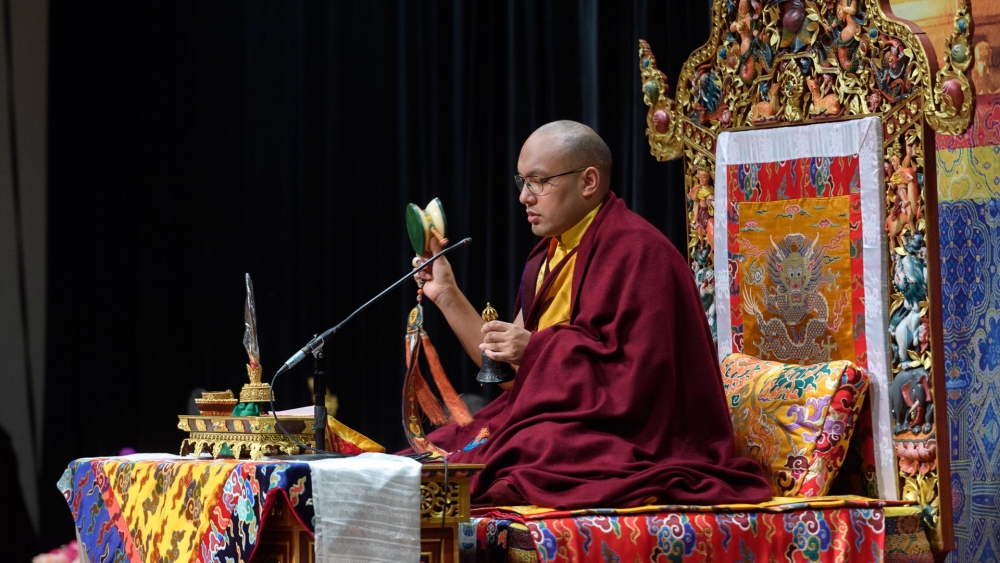Monlam Pavilion, Bodhgaya, India, January 3, 2014
In the morning session the Gyalwang Karmapa had explored the meaning of taking refuge and described how to visualize the refuge tree. After lunch he resumed his exposition of the text, blending an oral transmission of Jamgön Kongtrul Lodrö Thaye’s commentary with his own insights and much practical advice.
Only the Three Jewels are able rescue us from samsara. How then can we test the depth and authenticity of our refuge for ourselves?
First we can use the four measures:
1. We need to be clearly aware of their unique attributes. This includes the qualities of body, speech, mind and activity. The greatest and most immediate benefit for us comes from the qualities of the Buddha’s speech. As to mind, the qualities of the Dharma are immeasurable because not only does it include the individual attributes of the Dharma of tradition and the Dharma of realization, but at the heart of the Dharma is the truth of the path and the truth of cessation. Ultimately, every good result from our practice, such as higher rebirth and realisations, comes from the Dharma. The qualities of the Sangha are exemplified by Arya Bodhisattvas and Arya Shravakas.
2. We contemplate the differences between the Three Jewels – in nature, function and activity.
3. There are the distinct commitments we make to each of the Three Jewels. We accept the Buddha as our teacher, we accept the Dharma as a valid path, and we accept the Sangha as our guides and companions.
4. There are the abstentions that we vow to uphold: having taken refuge in the Buddha, we abstain from taking refuge in worldly deities.
Having entrusted ourselves completely to the Three Jewels we do not seek refuge elsewhere. They provide both protection and support, but we should never view them as a temporary refuge. Our ultimate aim is to attain the state of the Three Jewels ourselves, thus we need to go for refuge lifetime after lifetime until we achieve our goal.
The Indian Buddhist tradition had a three-fold refuge of Buddha, Dharma and Sangha, but also a five-fold refuge which included the yidams and dharmapalas. The story goes that because ancient Indian Buddhists had sharp faculties, they were very aware that one gains access to the Buddha through the guru and that the two are inseparable. But in Tibet, though there was great faith, Tibetans found it difficult to remember the unity of the guru and the Buddha so it was necessary to add going to refuge to the guru separately in the refuge vow, making a four-fold or six-fold refuge.
Why is the guru seen as inseparable from the Buddha? We often forget that the Buddha was a human being who attained enlightenment at Bodhgaya; we think of him as superhuman or god-like. In fact we are not always able to conceive of his qualities. The etymology of the word ‘guru’ suggests the meaning ‘weighty’, not in terms of size but in terms of positive attributes and great kindness. We see our guru as a human being and are able to see his or her qualities clearly. Using the analogy of the sun, the Karmapa explained the sun produces many different sorts of energy of which light is one form, but human beings are unable to see other parts such as X-rays. We only see what we have the capacity to see.
If we rely authentically on the guru, then through the guru’s blessing, we may at some point develop to the point where we can find out for ourselves whether there is anything greater or not. But if we don’t rely upon the guru and spend our lives searching, looking for something better than the guru, we may simply fall in between. Having failed to rely on the guru, we don’t receive their blessing. Not finding the superior thing of which we dream, we don’t receive its blessing either.
It is tempting to indulge in philosophical speculation over what constitutes the Three Jewels; however, if we are immersed fully in practice and want to foster virtue we should develop devotion as much as possible. Any image of the Buddha is a focus of support for faith, as are stupas which represent the Buddha, and should be considered as aspects of the Buddha. Dharma texts, and sangha members who keep ethical discipline should also be considered aspects of the Three Jewels, and one should go to them for refuge with faith and devotion.
Refuge has to become part of our daily life and we need to develop an experiential feeling of refuge in our minds, having a clear visualization of the refuge tree is not enough. Nor is it sufficient to repeat the words of the refuge vow. We need a strong, intense feeling of what refuge means. For example we say we take refuge in the Dharma, but are we actually practising the Dharma? For instance, during the Monlam there’s a lot of gossip, and too much talk about the faults of others, complaining, and negative comparisons. But if we have taken refuge in the Dharma we have a responsibility not to talk of another’s faults, but to talk of their virtues. As the Kagyu Monlam is a time when we try to improve ourselves rather than to cultivate negativity, His Holiness asked everyone to resolve to maintain ethical discipline in their speech and behavior in order to make the Monlam meaningful. Of course we have faults, he admitted, we are just human beings, but the life tree of the Dharma is to focus on other’s virtues rather than their faults.
When we rely on a spiritual friend, the sutras say that it is very difficult to find someone who is perfect, who lacks flaws, so it is sufficient to rely on a spiritual friend with the best qualities and the least flaws. We should be like bees, taking only the nectar from flowers and leaving the rest. We should focus on the good qualities of others and not their defects. We are trying to improve ourselves, increasing the virtues of our body, speech and mind. Paying attention to the good qualities of others will inspire us and we will develop a stronger faith, more devotion, and more love and compassion. This will be to our benefit.
Even if someone has only the slightest virtue, you should perceive the quality as rare and as precious as the Buddha. If we take refuge in the Dharma and focus only on the defects of others, we are paying lip service to the Dharma. We do not afford enough respect to the living virtues of those around us. And in the case of someone we dislike, we dwell on their negative side and ignore any virtues they might have.
For your refuge to qualify as a Mahayana refuge, it is of great importance to take refuge from now until enlightenment and to take it for all sentient beings as vast as space, and then it will be an authentic refuge.
In addition, there are four attributes which make refuge truly authentic
- An understanding of the qualities of the Three Jewels;
- An understanding of the superiority of and difference between the Buddha and other lesser teachers, the Dharma and incorrect paths, and the Sangha as opposed to the communities of other traditions.
- Having an unreserved commitment to the refuge based on an understanding of the superior qualities of the Three Jewels.
- Never giving up the refuge vows, even at the cost of your own life.
If we entrust ourselves without reservation to the Three Jewels, whatever difficulties we may encounter, even in lower rebirths, we will be protected. We re-enforce our commitment by contemplating the four recollections: their kindness, their compassion, the benefits of refuge, and the shortcomings of samsara,
Finally, His Holiness observed that when people complete the first preliminary practice, they often do prostrations along with recitation of the refuge vows. Over time, the custom has become to count the prostrations, but this is not correct. It’s the number of repetitions of the refuge vows which counts. People who cannot prostrate, because of physical difficulties can complete these preliminaries by reciting the refuge vow 100,000 times.



